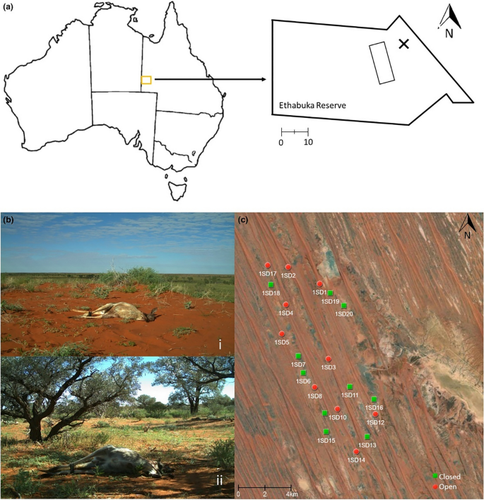Oecologia ( IF 2.7 ) Pub Date : 2024-04-08 , DOI: 10.1007/s00442-024-05531-0 Zyna Krige , Emma E. Spencer , Mathew S. Crowther , Christopher R. Dickman , Thomas M. Newsome

|
Scavenging dynamics are influenced by many abiotic and biotic factors, but there is little knowledge of how scavengers respond to extreme weather events. As carrion is a major driver of the organisation and structure of food webs within ecological communities, understanding the response of scavengers to extreme weather events is critical in a world that is increasingly subject to climate change. In this study, vertebrate scavenging and carcass persistence rates were quantified in the Simpson Desert of central Australia; a system that experiences major fluctuations and extremes in weather conditions. Specifically, a total of 80 adult red kangaroo (Osphranter rufus) carcasses were placed on the landscape and monitored using remote sensor cameras. This included 40 carcasses monitored before and then 40 carcasses monitored after a major flooding event. The carcasses were monitored equally before and after the flood across different seasons (warm and cool) and in dune and interdune habitats. Overall, a total of 8124 scavenging events for 97,976 visitation minutes were recorded for 11 vertebrate species within 30 days of carcass placement pre- and post-flood. Vertebrate scavenging increased post-flood in the warm season, especially by corvids which quadrupled their scavenging events during this time. There was little difference in carcass persistence between habitats, but carcasses persisted 5.3-fold longer post-flood in warm seasons despite increased vertebrate scavenging. The results demonstrate that a flood event can influence scavenging dynamics and suggest a need to further understand how seasons, habitats and extreme weather events can drive changes in carrion-based food webs.
中文翻译:

洪水、季节和栖息地相互作用,导致脊椎动物食腐和尸体存留率发生变化
食腐动物的动态受到许多非生物和生物因素的影响,但人们对食腐动物如何应对极端天气事件知之甚少。由于腐肉是生态群落内食物网组织和结构的主要驱动力,因此在日益受到气候变化影响的世界中,了解食腐动物对极端天气事件的反应至关重要。在这项研究中,对澳大利亚中部辛普森沙漠的脊椎动物食腐率和尸体存留率进行了量化;一个经历重大波动和极端天气条件的系统。具体而言,总共 80 具成年红袋鼠 ( Osphranter rufus ) 尸体被放置在景观中,并使用远程传感器摄像机进行监控。其中包括在重大洪水事件发生前监测的 40 具尸体和在重大洪水事件后监测的 40 具尸体。在洪水前后不同季节(温暖和凉爽)以及沙丘和沙丘间栖息地对尸体进行了同等监测。总体而言,在洪水前后尸体放置的 30 天内,共记录了 11 种脊椎动物的 8124 次食腐事件,持续时间为 97,976 分钟。洪水过后的温暖季节,脊椎动物的食腐活动增加,尤其是鸦科鸟类,它们在此期间的食腐活动增加了四倍。不同栖息地之间的尸体持久性几乎没有差异,但在温暖的季节,尽管脊椎动物的食腐活动增加,但在温暖的季节,尸体的持久性却延长了 5.3 倍。结果表明,洪水事件会影响腐肉动态,并表明需要进一步了解季节、栖息地和极端天气事件如何驱动腐肉食物网的变化。



























 京公网安备 11010802027423号
京公网安备 11010802027423号